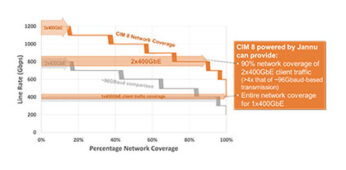Today, service providers need to be nimble and adaptable to address today’s changing network requirements and growing bandwidth demand. Some are turning to coherent solutions that offer configuration flexibility including transmission options from 100G to 1.2T. These solutions enable common hardware to address multiple deployment scenarios and reduce the need for costly regeneration nodes for long-haul and ultra-long-haul links.
As an example, Acacia’s high-performance Pico DSP-based 1.2 Terabit solution is currently deployed in well over one hundred networks around the globe and has been adopted by three of the four largest hyperscalers. In 2020 alone, Acacia shipped more than 30,000 Pico-based ports as customers increasingly recognized the competitive benefits that high-performance, flexible coherent transmission solutions can provide.
Network Transmission Flexibility Benefits
Multi-haul coherent solutions like the Pico DSP-based 1.2 Terabit solution are software configurable transponder modules that provide various transmission capacities and reaches. By varying the modulation order and baud rate settings, it can provide flexible options for service providers.

A multi-haul coherent solution addresses a range of network applications.
Balancing Modulation Order and Baud Rate
A common method of increasing throughput of a coherent channel is to increase the modulation order. However, this may result in a reduction in reach due to reduced optical signal to noise ratio (OSNR) tolerance for the higher modulation orders. Alternatively, the baud rate could be increased while maintaining a lower modulation order which provides additional capacity per channel with minimal sacrifice to reach.
Maximizing the channel capacity using continuously tunable baud rate can convert unused spectrum into usable capacity, with the goal to fill up the available channel bandwidth. However, as discussed in this whitepaper, increasing baud rate provides minimal improvements in fiber capacity once the transmission is well-matched to the channel.

Increasing transmission baud rate proportionally increases the transmission spectrum and can be used to convert unused spectrum into useable extra capacity.
With transmission flexibility, service providers can configure their client traffic with the following flexible options:
- 12×100 GbE or 3×400 GbE with 64 QAM modulation for DCI edge applications
- 8×100 GbE or 2×400 GbE with 16 QAM modulation for metro/regional and long haul
- 4×100 GbE or 1×400 GbE QPSK for the most challenging terrestrial and submarine networks
To ensure a smooth migration from 100GbE to 400GbE, it’s important to have a solution that can efficiently transport either type of traffic, or a combination of both, without restrictions on performance and functionality.
Increase Performance and Reach with 400GbE Long Haul
With 400GbE becoming the “common currency” for high-capacity Ethernet transmission, it’s important to have a solution that can support this traffic over long distances. For service providers supporting 400GbE traffic they can use Acacia’s Pico DSP-based solution and choose from various configurations, as previously mentioned, including the option to combine two 400GbE client signals into an 800G 150 GHz channel for transmission over their metro and long-haul networks.

Leveraging Acacia’s Pico DSP-based solution service providers can combine two 400GbE client signals into an 800G 150GHz channel for long haul transmission.
Migrating from 100G to Higher Speeds Just Got Easier
Multi-haul coherent solutions enable network operators to easily migrate from 100G traffic toward 400G and higher speeds to deploy new and exciting applications and services. Networks utilizing flexible coherent transmission can provide support for growing client traffic across the entire network—from DCI edge, metro, long-haul, and all the way to submarine. Learn more in this video.


